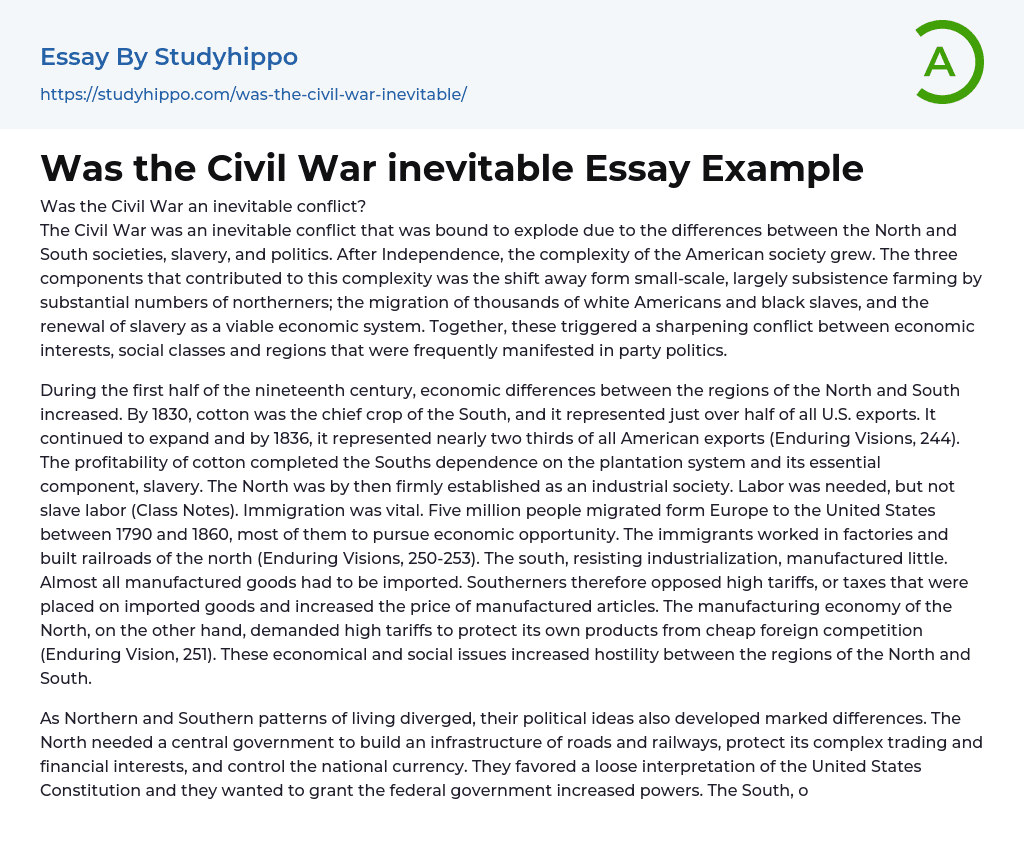Was the Civil War an unavoidable conflict?
Yes, the Civil War was an unavoidable conflict that was destined to erupt due to the disparities between the Northern and Southern societies, the institution of slavery, and political differences. Following the attainment of Independence, the American society became more intricate. This complexity was brought about by three factors: the transition of a noteworthy number of northerners from small-scale farming to other economic activities, the movement of numerous white Americans and enslaved black individuals, and the resurgence of slavery as a viable economic system. These factors combined to ignite a growing conflict between economic interests, social classes, and regions, which often manifested in political party rivalries.
During the first half of the nineteenth century, there was a growing economic disparity between the North and South regions. The South heavily relied on cot
...ton as its main crop, which accounted for more than 50% of all U.S. exports by 1830 and almost two-thirds by 1836. This heavy reliance cemented the South's dependence on slavery and plantations. On the other hand, the North had evolved into an industrial society that did not rely on slave labor but instead utilized immigration to fulfill their labor needs. From 1790 to 1860, approximately five million Europeans migrated to the United States in search of economic opportunities, playing a crucial role in Northern factories and railroad construction.
The South resisted industrialization and largely imported manufactured goods rather than producing them domestically. As a result, they opposed high tariffs that increased prices for these goods. Conversely, the North's manufacturing-based economy required high tariffs to safeguard their products from inexpensive foreign competition. These economic and social issues intensified animosity betwee
the North and South regions.
As the patterns of living in the North and South grew apart, so did their political beliefs. The North saw the need for a centralized government to develop transportation systems, protect trade and finances, and regulate currency. They supported a loose interpretation of the US Constitution and desired to grant more power to the federal government. Conversely, the South wished to reserve unspecified powers for individual states. They opposed government-sponsored internal improvements like roads, railroads, and canals. The South relied less on the federal government compared to other regions, leading Southerners to see no reason to strengthen it. Additionally, Southern patriots feared that a strong central government might intervene in the matter of slavery. These issues set the stage for the inevitable conflict that lay ahead.
Between 1846 and 1848, questions about territorial expansion fueled sectional conflict. After the war ended, the United States had an equal number of free and slave states, but the new land acquired threatened to disrupt this balance. Any resolution regarding slavery was bound to create controversy. The Southern states were deeply upset by the notion that the federal government could prohibit slavery in the Western territories. They believed it would limit the number of slave states in the Union while free states continued to multiply. Many Southerners feared that as the government became increasingly dominated by free states, it would eventually jeopardize established slaveholdings. This led to strong opposition in the South against any attempts to impede the expansion of slavery. If the federal government did manage to exercise this power, many Southern political leaders threatened secession as a means of protecting states' rights. The idea
of extending the Missouri Compromise line of 36 30 further angered those in favor of abolishing slavery, as it would permit its practice in New Mexico and southern California. The third option, popular sovereignty, which allowed each territory to decide for itself, failed to please either group. This situation escalated and thrust the nation into crisis.The American Civil War became unavoidable as the social, economic, and political differences between the two regions grew over time. These differences, which can be traced back to colonial times, continuously pushed the two sections further apart. The intense efforts of each region to assert their views made it difficult to reach a compromise. Compromises were crucial in maintaining unity within the Union, but when compromises were not possible, tensions escalated.
- Slave Trade essays
- American Civil War essays
- Atomic Bomb essays
- Attack essays
- Cold War essays
- Crimean War essays
- Diplomacy essays
- Emilio Aguinaldo essays
- Emperor essays
- Hitler essays
- Iraq War essays
- Korean War essays
- Mexican American War essays
- Nazism essays
- Nuclear Weapon essays
- Philippine Revolution essays
- Revolutionary War essays
- Rwanda essays
- The Spanish American War essays
- Trench Warfare essays
- Tribe essays
- Vietnam War essays
- War of 1812 essays
- Western Front essays
- World War I essays
- World War Ii essays
- Abolitionism essays
- Adam Smith essays
- American History essays
- American Revolution essays
- Ancient Egypt essays
- Articles Of Confederation essays
- Atlantic Slave Trade essays
- Aztec essays
- Benjamin Franklin essays
- Civil Rights Act of 1964 essays
- Civil Rights Movement essays
- Civil war essays
- Cleopatra essays
- French And Indian War essays
- Gettysburg essays
- Great Depression essays
- Hurricane Katrina essays
- Industrial Revolution essays
- Jamestown essays
- Manifest Destiny essays
- Mccarthyism essays
- Patrick Henry essays
- Pearl Harbor essays
- Pocahontas essays




